check engine GMC JIMMY 1997 Owner's Guide
[x] Cancel search | Manufacturer: GMC, Model Year: 1997, Model line: JIMMY, Model: GMC JIMMY 1997Pages: 410, PDF Size: 20.03 MB
Page 275 of 410
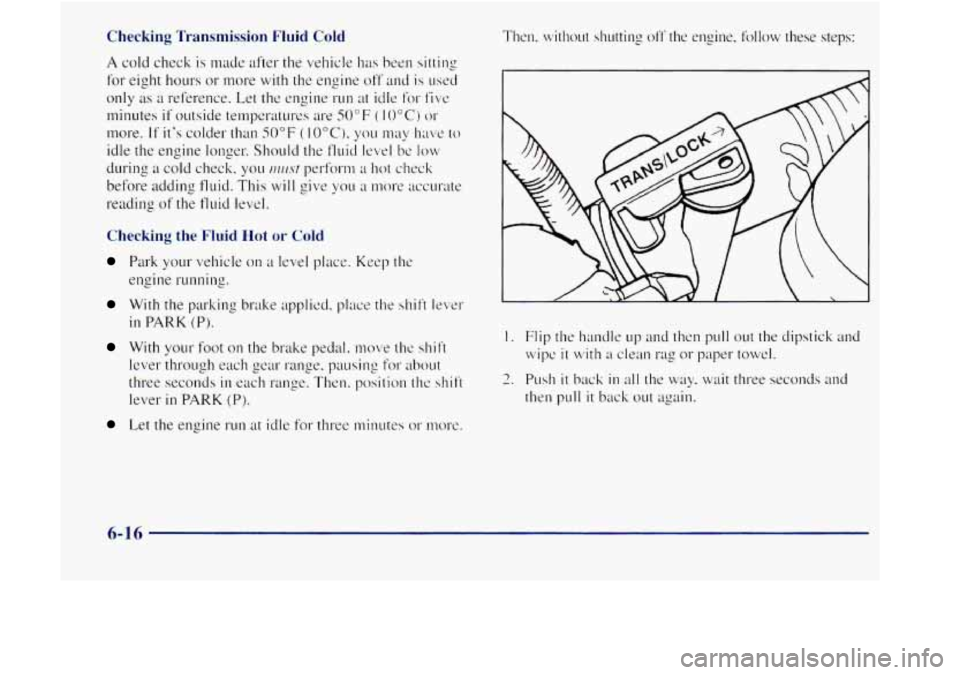
Checking Transmission Fluid Cold
A cold check is made after the vehicle hus been sitting
for eight hours or
Inore with the engine off and is lwd
only as a reference. Let the engine run rlt idle for five
minutes
if outside temperatures are 50°F ( 10°C) oI
more. If it’s colder than 50°F ( IOOC), you may have to
idle the engine longer. Should the fluid level be low
during a cold check, you rrlwst perfor111 a hot check
before adding fluid. This
will give you a more accurate
reading
of the fluid level.
Checking the Fluid Hot or Cold
Park your vehicle on a level place. Keep the
engine running.
With the parking brake applicd. place the shift le\;er
in PARK (P).
With your foot on the brake pedal, move the shift
lever through each
gear range, pausing for about
three seconds
in each range. Then. position the shit’t
lever
in PARK (P).
Let the engine run at idle for three minutes or more.
I. Flip the handle LIP and then pull out the dipstick and
wipc it with a clean rag or paper towel.
2. Push it back in all the way, wait three seconds and
then pull it back out again.
6-16
Page 277 of 410
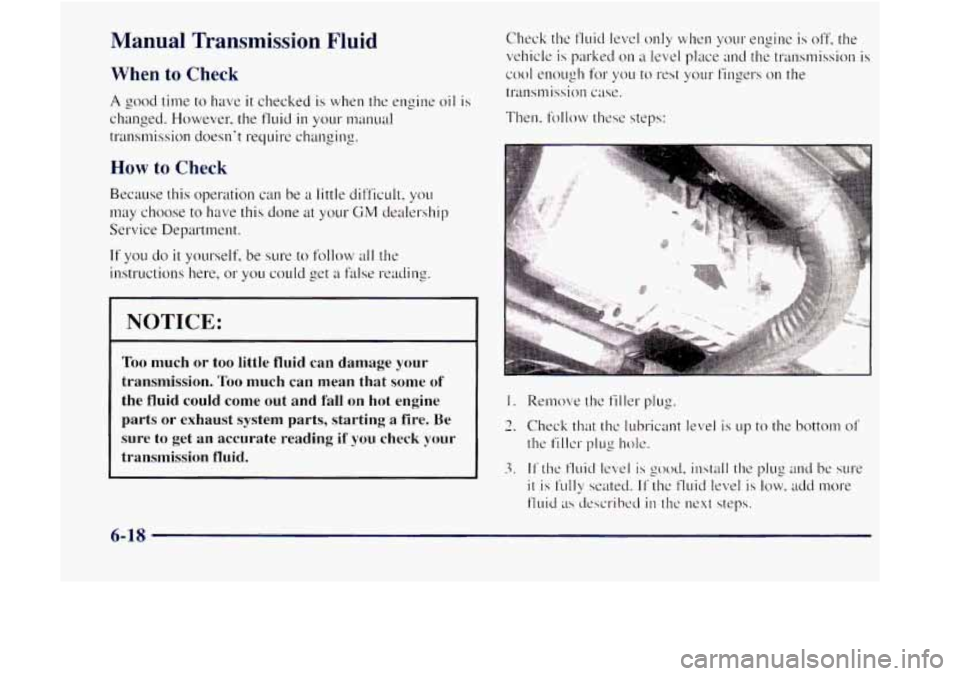
Manual Transmission Fluid
When to Check
A good time to have it checked is when the engine oil is
changed. However, the fluid in YOLK manual
transmission doesn't require changing.
How to Check
Because this operation can be a little dii'licult, you
may choose to have this done at your GM dealership
Service Department.
If you do it yourself, be sure to follow all the
instructions here, or you could get
false reading.
NOTICE:
Too much or too little fluid can damage your
transmission.
Too much can mean that some of
the fluid could come out and fall on hot engine
parts or exhaust system parts, starting a
fire. Be
~ sure to get an accurate reading if you check your
~ transmission fluid.
6-18
Page 283 of 410
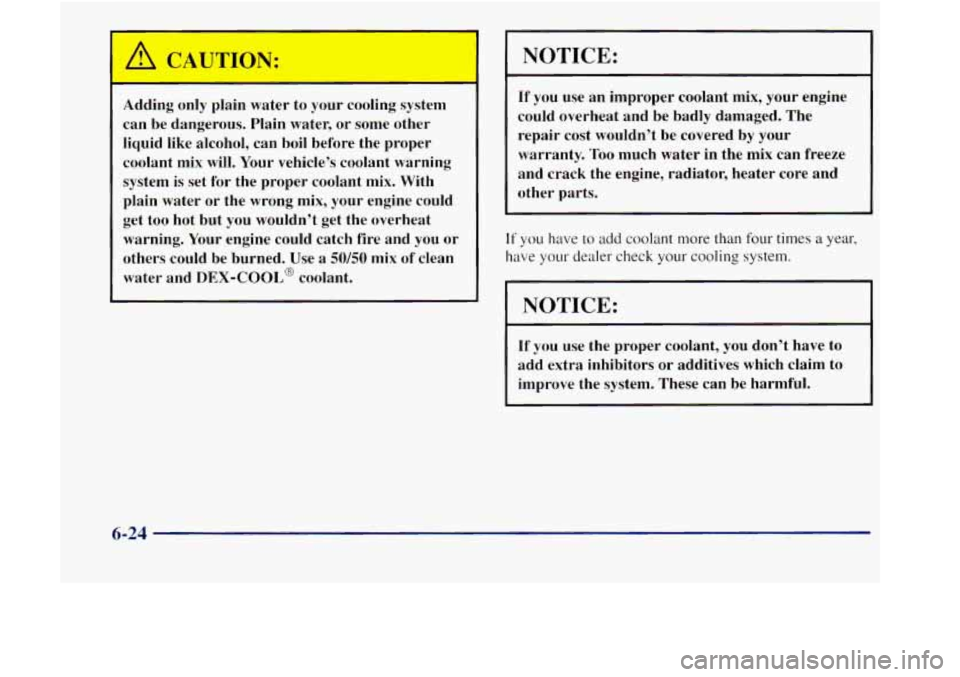
Adding only plain water to your cooling system can be dangerous. Plain water, or some other
liquid like alcohol, can boil before the proper
coolant mix will. Your vehicle’s coolant warning
system
is set for the proper coolant mix. With
plain water or the wrong mix, your engine could
get too hot but you wouldn’t get the overheat warning. Your engine could catch fire and you or
others could be burned. Use a
50/50 mix of clean
water and
DEX-COOL@ coolant.
NOTICE:
If you use an improper coolant mix, your engine
could overheat and be badly damaged. The
repair cost wouldn’t be covered by your
warranty.
Too much water in the mix can freeze
and crack the engine, radiator, heater core and
other parts.
If you have to add coolant more than four times a year,
have your dealer check your cooling
system.
I NOTICE:
If you use the proper coolant, you don’t have to
add extra inhibitors or additives which claim to improve the system. These can be harmful.
6-24
Page 284 of 410

Checking Coolant
When your engine is cold. the coolant level should be at
ADD, or a little higher. When your engine is warm. the
level
should be up to FULL HOT, or a little higher.
Adding Coolant
If you need more coolant, add the proper DEX-COOL'
coolant mixture crt rhe cwolcrllt I-KO\!PI-J tcrnk.
~ ' Turning the radiator pressure cap when the
engine and radiator are hot can allow steam and
scalding liquids to blow out and burn
you badly.
With the coolant recovery tank,
you will almost
never have to add coolant at the radiator.
Never turn the radiator pressure cap
-- even a
little
-- when the engine and radiator are hot.
Add DEX-COOL@ coolant mixture at the recovery
tank, but be careful not to spill
it.
You can be burned if you spill coolant on hot
engine parts. Coolant contains ethylene glycol,
and it will burn
if the engine parts are hot
enough. Don't
spill coolant on a hot engine.
6-25
Page 286 of 410

When to Check Power Steering Fluid
It is not necessary to regularly check power steering
fluid ~rnless
you suspect there is a leak in the system or
you hear an unusual noise. A fluid loss in this system
could indicate
a problem. Have the system inspected
and repaired.
How To Check Power Steering Fluid
When the engine compartment is cool, wipe the cap and
the top of the reservoir clean, then unscrew the cap and
wipe
the dipstick with a clean rag. Replace the cap and
completely tighten
it. Then remove the cap again and
look at the fluid level on the dipstick.
The level should be between the
ADD and FULL marks.
If necessary, add only enough fluid to bring the level up
to the proper range.
What to Use
Windshield Washer Fluid
What to Use
When you need windshield washer fluid. be sure to read
the manuf‘~cturer’s instructions before ~rse.
If you will be
operating your
\:chicle in an area where the temperature
may fall below freezing,
LIS~ a fluid that has sufficient
protection against freezing.
Adding Washer Fluid
To determine what kind of fluid to use, see
“Recommended Fluids and Lubricants”
in the Index.
Always use the proper fluid. Failure to use the proper
fluid can cause leaks and damage hoses and seals.
Open
the cap labeled WASHER FLUID ONLY with the
washer symbol 011 it. Add washer tluid until the tank is full.
6-27
Page 288 of 410

There are only two reasons why the brake fluid level in
the reservoir might go down. The first is that the brake
fluid goes down to an acceptable level during normal
brake lining wear. When new linings are put in, the fluid
level goes back up. The other reason is that fluid is
leaking out of the brake system. If it is, you should have
your brake system fixed, since a leak means that sooner
or later your brakes won’t work well, or won’t work
at all.
So, it isn’t a good idea to “top off’ your brake fluid.
Adding brake fluid won’t correct a leak. If you add fluid
when your linings
are worn, then you’ll have too much
fluid when you get new brake linings. You should add
(or remove) brake fluid, as necessary, only when work is
done on the brake hydraulic system. Refer
to the Maintenance Schedule to determine when to
check your brake fluid. See “Periodic Maintenance
Inspections” in the Index.
Checking Brake Fluid
If you have too much brake fluid, it can spill on the
engine. The fluid
wiu burn if the engine is hot
enough.
You or others could be burned, and your
vehicle could
be damaged. Add brake fluid only
when work
is done on the brake hydraulic system.
I
You can check the brake fluid without taking off the cap.
Just look at the windows on the brake fluid reservoir. The fluid levels should be above MIN. If they aren’t,
have your brake system checked to see
if there is a leak.
After work is done on the brake hydraulic system, make
sure the levels are above
MIN and below the top of
each window.
6-29
Page 317 of 410

Vehicle Identification Number (VIN)
m I11111111 1111 111 111111 111 111111 I1 111111111111 111111111 II, 0
I d SAMPLE4UXVM072675
I ENGINEb7 f ASSEMBLY I
CODE MODEL YEAR PLANT ~~
This is the legal identifier for your vehicle. It appears on
a plate in the front corner of the instrument panel, on the
driver's side. You can see
it if you look through the
windshield from outside your vehicle. The
VIN also
appears on the Vehicle Certification and Service Parts
labels and the certificates of title and registration,
Engine Identification
The 8th character in your VIN is the engine code. This
code
will help you identify your engine, specifications
and replacement parts.
Service Parts Identification Label
You'll find this label on the inside of the glove box. It's
very helpful if you ever need to order parts. On this
label is:
your VIN,
the model designation.
paint information and
a list of all production options and special equipment.
Be sure that this label is not removed from the vehicle,
Electrical System
Add-on Electrical Equipment
NOTICE:
Don't add anything electrical to your vehicle unless
you check with your dealer first. Some electrical
equipment can damage your vehicle and the
damage wouldn't be covered by your warranty.
Some add-on electrical equipment can keep other
components from working
as they should.
Your vehicle has an air bag system. Before attempting to
add anything electrical to your vehicle, see "Servicing
Your Air Bag-Equipped Vehicle" in the Index.
6-58
Page 330 of 410
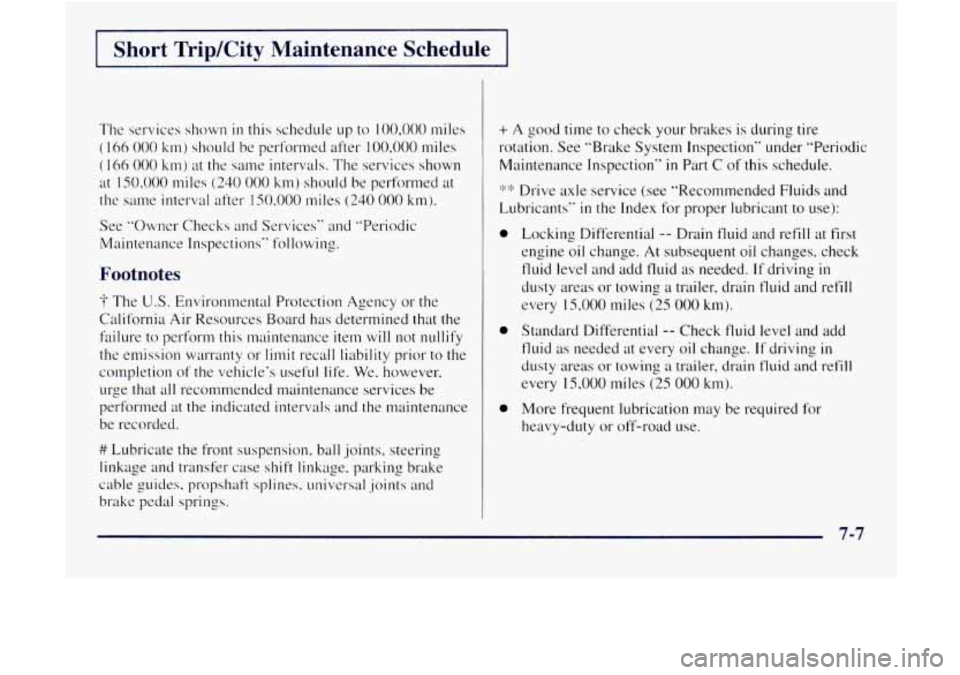
Short Trip/City Maintenance Schedule
The services shown in this schedule LIP to 100.000 miles
( I66 000 km) should be performed after 100,000 miles
( 166 000 km) at the same intervals. The services shown
at 150.000 miles (240
000 km) should be performed at
the
same interval after 150.000 miles (240 000 km).
See "Owner Checks and Services" and "Periodic
Maintenance Inspections" following.
Footnotes
-f The U.S. Environmental Protection Agency or the
California Air Resources Board has determined that the
failure to perform this maintenance item will not
nullify
the emission warranty or limit recall liability prior to the
completion
of the vehicle's useful life. We. however,
urge that
all recommended maintenance services be
performed at the indicated intervals and
the maintenance
be recorded.
## Lubricate the front suspension. ball joints. steering
linkage and transfer case shift linkage. parking brake
cable guides, propshaft splines. Lulivel-sal joints and
brake
pedal springs.
+ A good time to check your brakes is during tire
rotation. See "Brake System Inspection" under "Periodic
Maintenance Inspection"
in Part C of this schedule.
'i::k Drive axle service (see "Recommended Fluids and
Lubricants"
in the Index for proper lubricant to use):
0
0
0
Locking Differential -- Drain fluid and refill at first
engine oil change. At subsequent oil changes, check
fluid level and add fluid as needed.
If driving in
dusty areas or towing a trailer, drain tluid and refil
every 15,000 miles
(25 000 km).
Standard Differential
-- Check fluid level and add
tluid
as needed at every oil change. If driving in
dusty areas or towing a trailer, drain fluid and refil
every
15,000 miles (25 000 km).
More frequent lubrication may be required
for
heavy-duty or off-road use.
1
1
7-7
Page 331 of 410
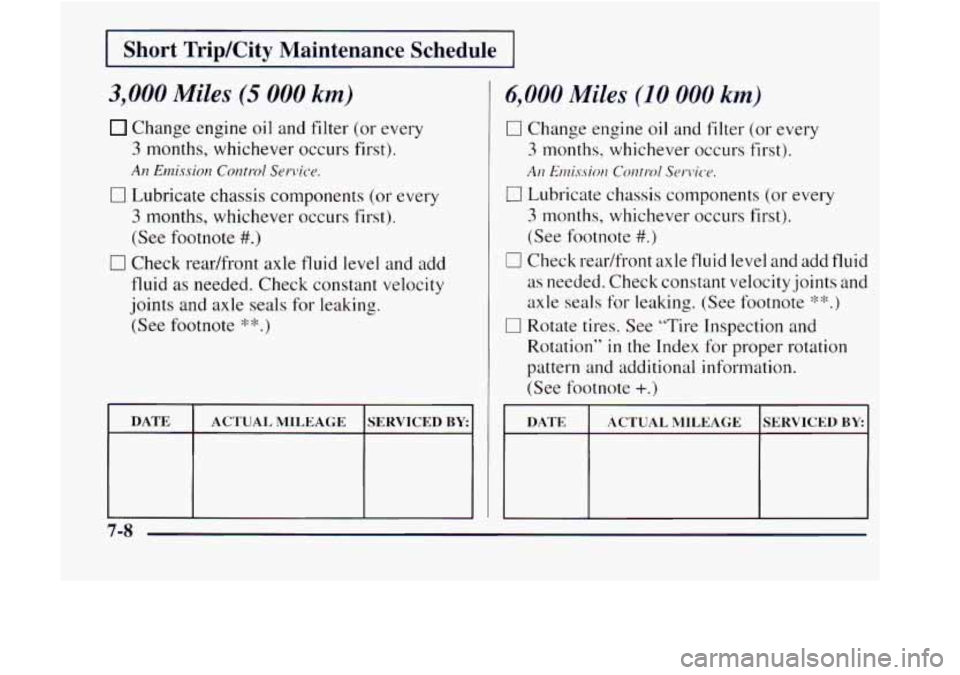
Short Trip/City Maintenance Schedule
3,000 Miles (5 000 km)
Change engine oil and filter (or every
3 months, whichever occurs first).
0 Lubricate chassis components (or every
3 months, whichever occurs first).
(See footnote
#.)
0 Check readfront axle fluid level and add
fluid
as needed. Check constant velocity
joints and axle seals for leaking.
(See footnote
?)
DATE SERVICED BY: ACTUAL MILEAGE
6,000 Miles (10 000 km)
CI Change engine oil and filter (or every
3 months, whichever occurs first).
A17 Emissiou Colltr-ol Sar.\.ic.e.
CI Lubricate chassis components (or every
3 months, whichever occurs first).
(See footnote
#.)
0 Check readfront axle fluid level and add fluid
as need.ed. Check constant velocityjoints and
axle seals
for leaking. (See footnote T)
0 Rotate tires. See “Tire Inspection and
Rotation”
in the Index for proper rotation
pattern and additional information.
(See footnote
+.)
I DATE I ACTUAL MILEAGE ISERVICED BY I
7-8
Page 332 of 410
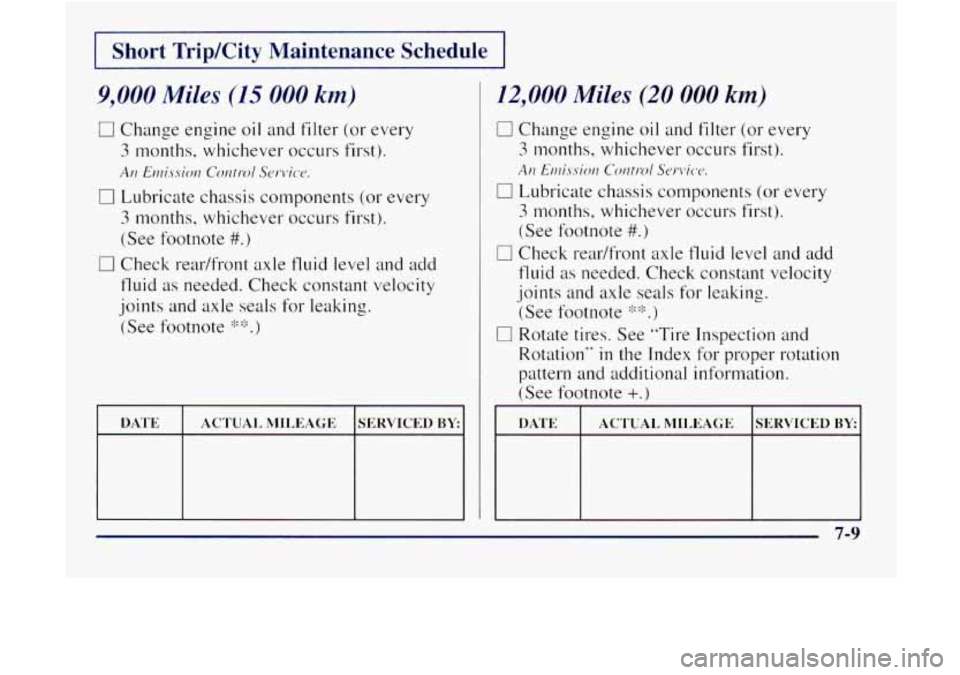
I Short Trip/City Maintenance Schedule I
9,000 Miles (15 000 km)
0 Change engine oil and filter (or every
3 months, whichever occurs first).
AH Emissio/1 Control Sc>t-\!ir-o.
0 Lubricate chassis components (or every
3 months, whichever occurs first).
(See footnote
#.)
0 Check readfront axle fluid level and add
fluid as needed. Check constant velocity
joints and axle seals for leaking.
(See footnote
'Y)
DATE SERVICED BY: ACTUAL IC.III,EAGE
12,000 Miles (20 000 km)
0 Change engine oil and filter (or every
3 months, whichever occurs first).
At! Emissio/l Control ScJl-\'ic.c.
0 Lubricate chassis components (or every
3 months. whichever occurs first).
(See footnote
#.)
0 Check rear/front axle fluid level and add
fluid as needed. Check constant velocity
.joints and axle seals for leaking.
(See footnote
'!?)
0 Rotate tires. See "Tire Inspection and
Rotation"
in the Index for proper rotation
pattern and additional information.
(See footnote
+.)
7-9